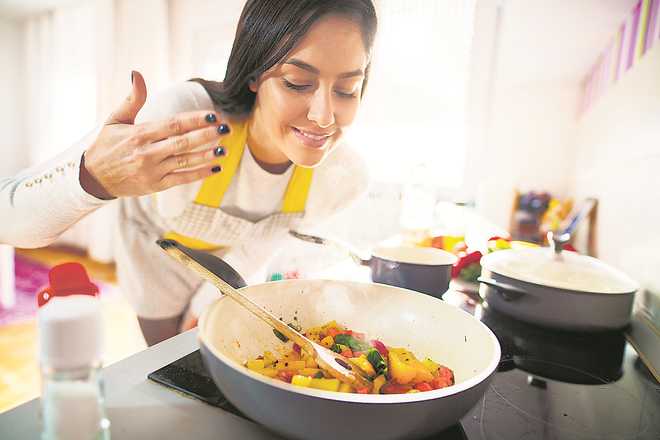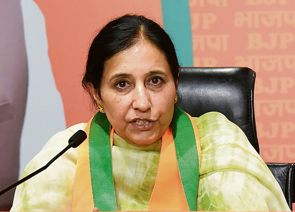
iStock
Pushpesh Pant
Many moons ago, Manish Malhotra of the ‘Indian Accent’ set the trend with his pioneering tasting menu. Exotic and expensive, it introduced the Indian diner to the joys of small delicious morsels, served over a multi-course meal. Since then, the concept has travelled across continents. A galaxy of young star chefs is at work at present, at home and abroad, who may rightly be called trendsetters. Take for instance, chef Gaggan Anand in Bangkok. Faceless foodies, celebrities and sundry tourists lined up at his outlet ‘Gaggan’ to literally lick the plate! Then there are chefs like Vineet Bhatia, Atul Kochar, Vikas Khanna, who have have collected the coveted Michelin stars.
Back home in India, interesting things are happening to our cuisine. The molecular culinary bubble has burst not a day too soon, and not much talked nowadays is the avant garde Indian or nouvelle Indian cuisine.
Indian chefs and diners have started flirting with flavours from hitherto forgotten neighbours like Burma and Vietnam. Cyber Hub has just come up with ‘Viet Nom’ gem of a restaurant that charmed the Vietnamese ambassador. He compared it very favourably with Michelin-starred Vietnamese restaurants in Paris. Chef Vaibhav Bhargava has recaptured the textures and taste of the Smaller Dragon brilliantly.
We have come a long way from food festivals celebrating broad categories like Awadhi, Kashmiri or Goa. Restaurants have now started doing ‘pop-ups’ of Oriya, Assamese, Garhwali, Kayasth and many more sub-regional and lesser-known ethnicities.
Most of the youngsters, particularly those under 30, are intrepid, itinerant and adventurous. This generation is willing to try everything, and more than once. Burgers, hot dogs and pizzas are passé. Thanks to liberalisation, these have been exposed, just like the exotic foreign fruits and vegetables. Here’s looking at some emerging food trends:
Home chefs come calling
Perhaps, the most powerful food trend surging through the nation is the glorification of home cooking by ‘housewife chefs,’ propelled strongly by the impulse of the millennials to research their roots and identity. The more traumatic the uprooting, the more passionate is the desire to eat one’s own food! In the Capital itself, there is no dearth of gifted housewives who are dazzling not only their guests with what they dish out but also sharing their recipes on many food blogs and YouTube channels. Rani Jinsi specialises in Kashmiri Pandit cuisine while Ritika Singh offers a mind-boggling array of Punjabi recipes that eschew cliches like dal makhani, kadhai paneer or murg malai tikka. She feeds her patrons the delectable aloo vadiyaan, baigan ka bhartha, finger-licking saag and bharwan tinde. Then there is Sneha Saikia, who has demystified the Northeast cuisine for the denizens of Delhi. Her repertoire has Assamia khar, maas tenga, an array of pork and chicken curries, with an accompaniment of wild brown rice, bamboo shoots with a hint of bhut jolokiya. Shipra Mishra, born to a Sindhi mother and Punjabi father, was raised in Udaipur and Mumbai. She married an Oriya and is proud to unveil household favourites. Her bhuno jeera parval ghonto, match besar with ambol and sago bhaja making you think again about what you have been missing.
Rushina Ghildiyal in Mumbai has been wowing diners with her home-cooked Garhwali food, tempered with aromatic jakhia, and exotic green vegetables like stinging Himalayan nettles (shishuna).
Revival of nostalgia
The other trend, following close on its heals, is the revival of nostalgia. Nostalgia for the Raj and Anglo-India, an incurable ache caused by unhealed wounds of Partition and twinge of pain at the loss of youth left far behind. The diners, who inspire cooks, are the post-middle aged ‘oldies’ and dwindling numbers of senior citizens who recall what they relished in undivided India. In ultra chic promenade doubling as a food court at the Aerocity in Delhi, there is a new eatery called Daryaganj that revives memories of 1950. It renders the original tandoori murg, dal gosht and ajwaini naan. There are many imitators who claim the creation of butter chicken but what is brought to you here is very different from the sweetish concoction that is purveyed elsewhere. It may, however, be noted, in passing, that gifted young celebrity chefs like Saransh Goela have ridden this nostalgia wave with a personalised recipe that mingles memory with desire. Michael Swamy, an exceptionally gifted cerebral chef, recently launched ‘Anglo’ in the much-maligned and misunderstood Khan Market in Lutyens Delhi. Ironically, the yearning for Anglo-Indian delicacies has been inversely proportional to the reducing number of this almost extinct community. Many youngsters belonging to affluent families acquire a taste of some mutant of this genre in a public school hostel. The Officer’s Mess in the armed forces and Anglicised Clubs, manager’s bungalows in tea and coffee plantations also have contributed to keeping this cooking style alive. Those who like to show off in public that they have sophisticated palates like to talk about the dak bungalow murgi roast, captain’s chicken, Mullingatawny soup, rum caramel custard, etc. Kolkata and Bengaluru are, perhaps, the best places to enjoy what remains of a resplendent legacy — Doll, bad word (meat balls) curry, saffron-tinged yellow rice and myriad cutlets.
Health on the mind
Many health conscious Indians, young and old, have started including oats and millets, quinoa and assorted seeds in their daily diet. Even those not enamoured by superfoods have begun to take organic produce seriously and vegans are no longer dismissed out of hand as cranks. The interesting thing is that traditional Indian repast for the common man in almost all regions of India has been based on coarse cereals, nutritious millets and seasonal vegetables grown organically. It is only in the past few decades that refined sugar, salt and oils have pushed off the healthier traditional ingredients from our thali. Nutritionist and doctors treating lifestyle diseases have, at long last, succeeded in making people worry about cholesterol, obesity, etc. This evangelism is not free from commercial concerns. A whole new industry has mushroomed marketing healthy breakfast cereals and nutritious supplements. More and more young, and young at heart, are opting for soups and salads at home. Upma, dosai, poha and cheela are increasingly being made with ragi, manduwa, bajra and jwar. Air-fryers have made it easy to indulge in comparatively guilt-free splurging of pakora and samosa. Even otherwise, baked and steamed or minimally stir-fried recipes are resorted to. Cold pressed oils and fresh fruit and vegetable juices, along with butter milk and herbal teas, are the preferred thirst quenchers.
Almonds, walnuts, cashewnuts, along with the proletarian peanut and parched gram and pounded rice flakes, have gained ascendency over what were once considered irresistible chips and dish namkeen mixtures. The shelves are overflowing with sun-dried wild berries, prunes and dates high in fibre. We believe like in the case of millets, Indians will soon enough discover the wonderful biodiversity that can nourish us better than the imported stuff. The Centre for Science and Environment has exerted tirelessly to propagate this cause. This trend is bound to gain strength in future.
Flavours from Mauryan Empire
The emergence of litthi choka in the NCR is an example of how the staple food of the impoverished masses from the rural hinterland has had its revenge, at last. The humble combo, traditionally slow cooked on cowdung cakes, is now turned out over chargrill installed in kiosks. It’s not only the burgeoning immigrant labour and student population that sustains these stalls, the locals too have shown a penchant for this healthy option. Puja Sahu started with a small entry Pot Belly in Shahpur Jat following it up soon with one in Bihar Bhawan and now has an outlet in Gurugram.
Periphery subdues the Centre
Momo has the distinction of displacing the local kebab from the top of the bestseller list. Once considered exotic and only available in dingy shops in Majnu ka Tila (Tib Dabs, short for Tibetan dhaba), it can now be enjoyed almost everywhere. To seduce and subdue Delhiites, it has even donned a tandoori garb. Make no mistake, it’s here to stay. Dimsums may claim more refined aristocratic lineage, but the rustic momo — be it from Ladakh, Nepal or Northeast — will survive better.



























